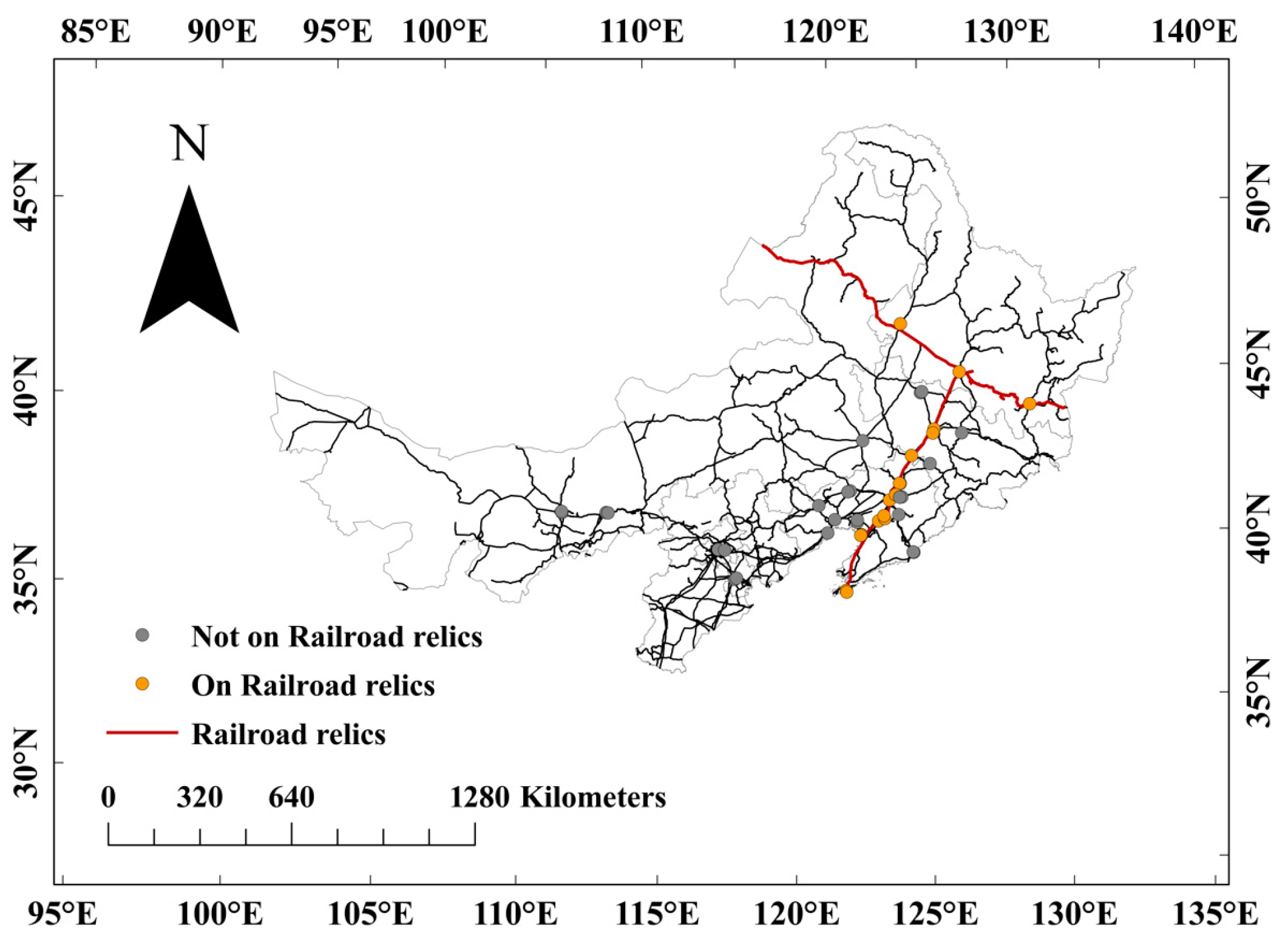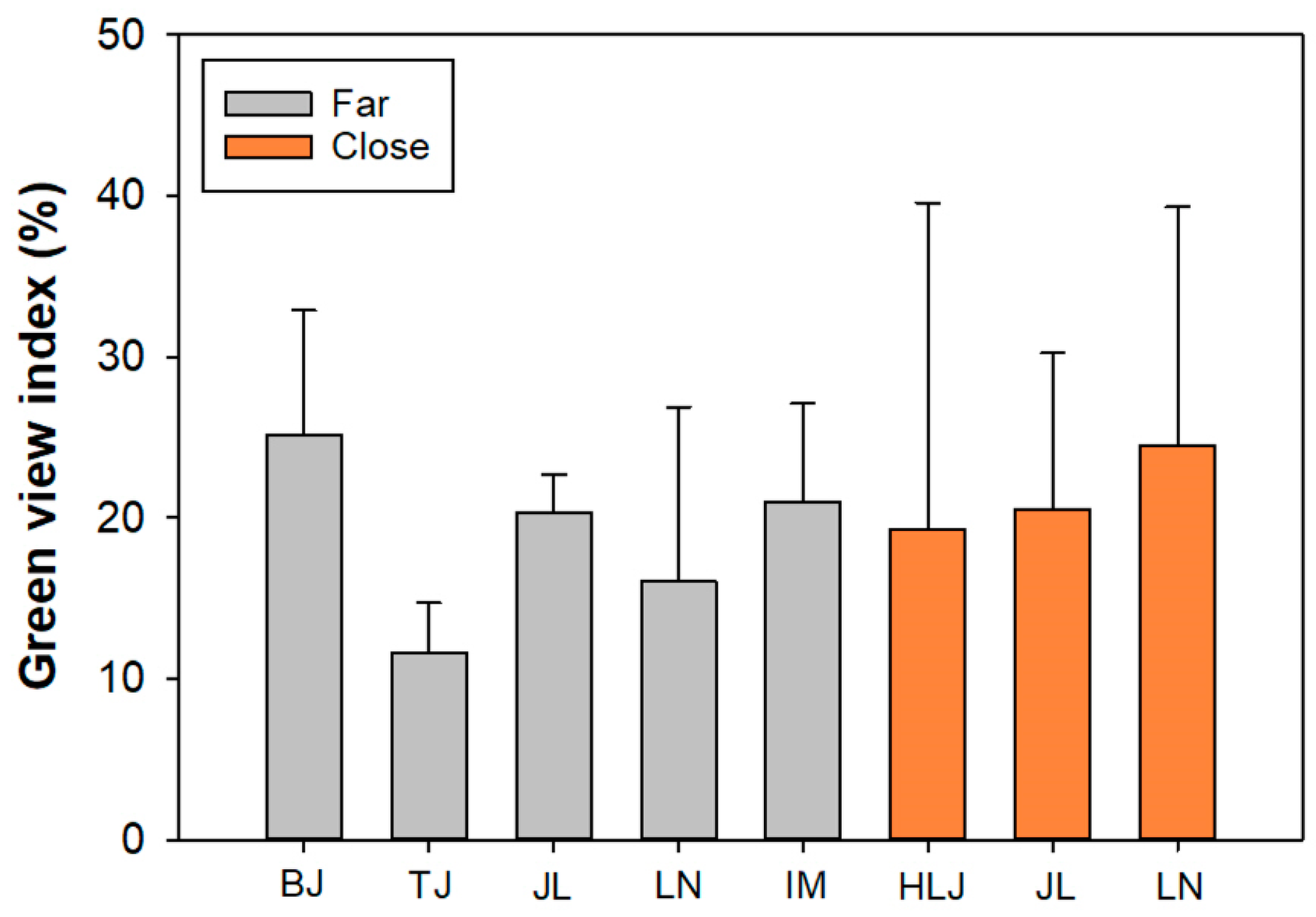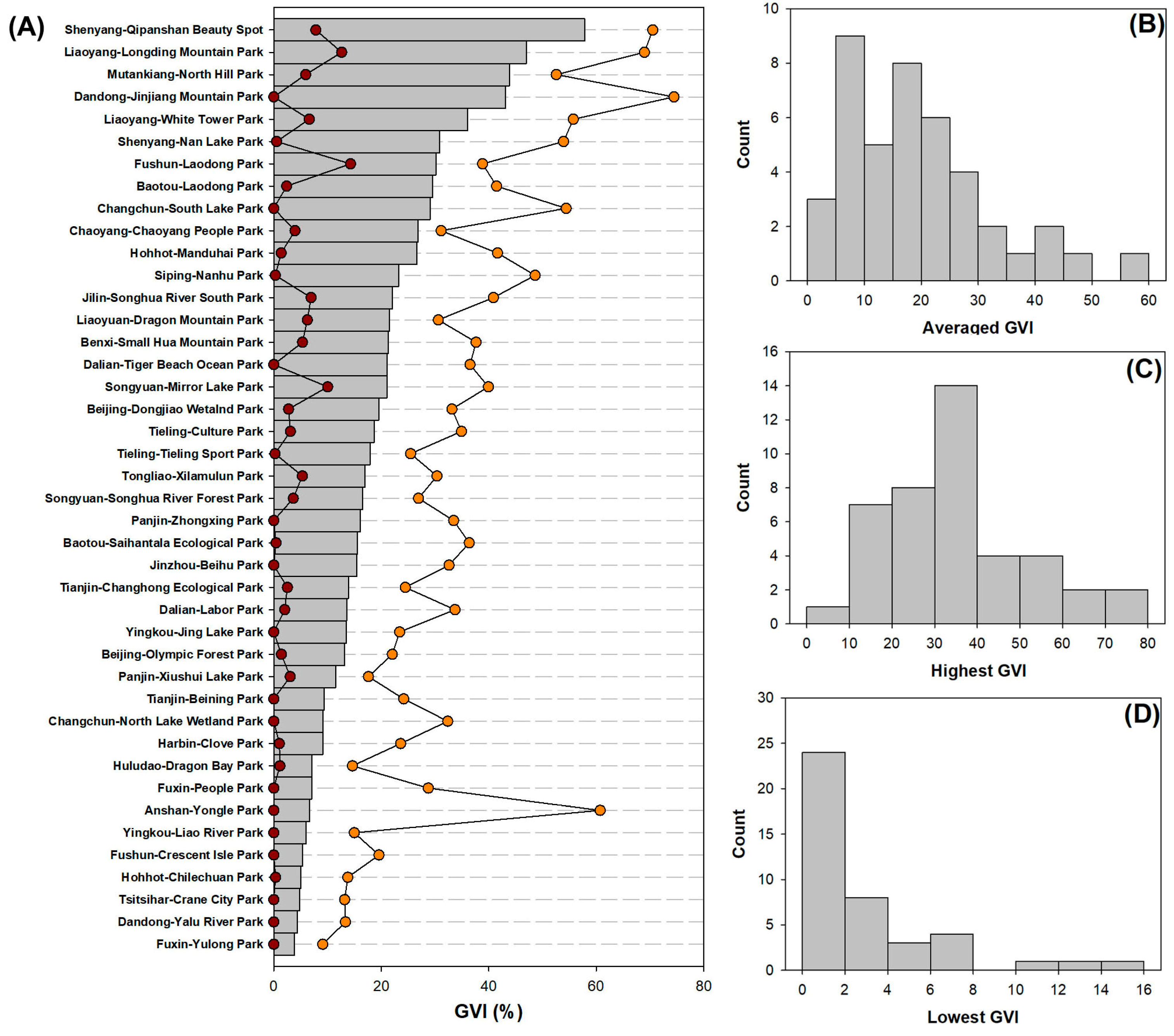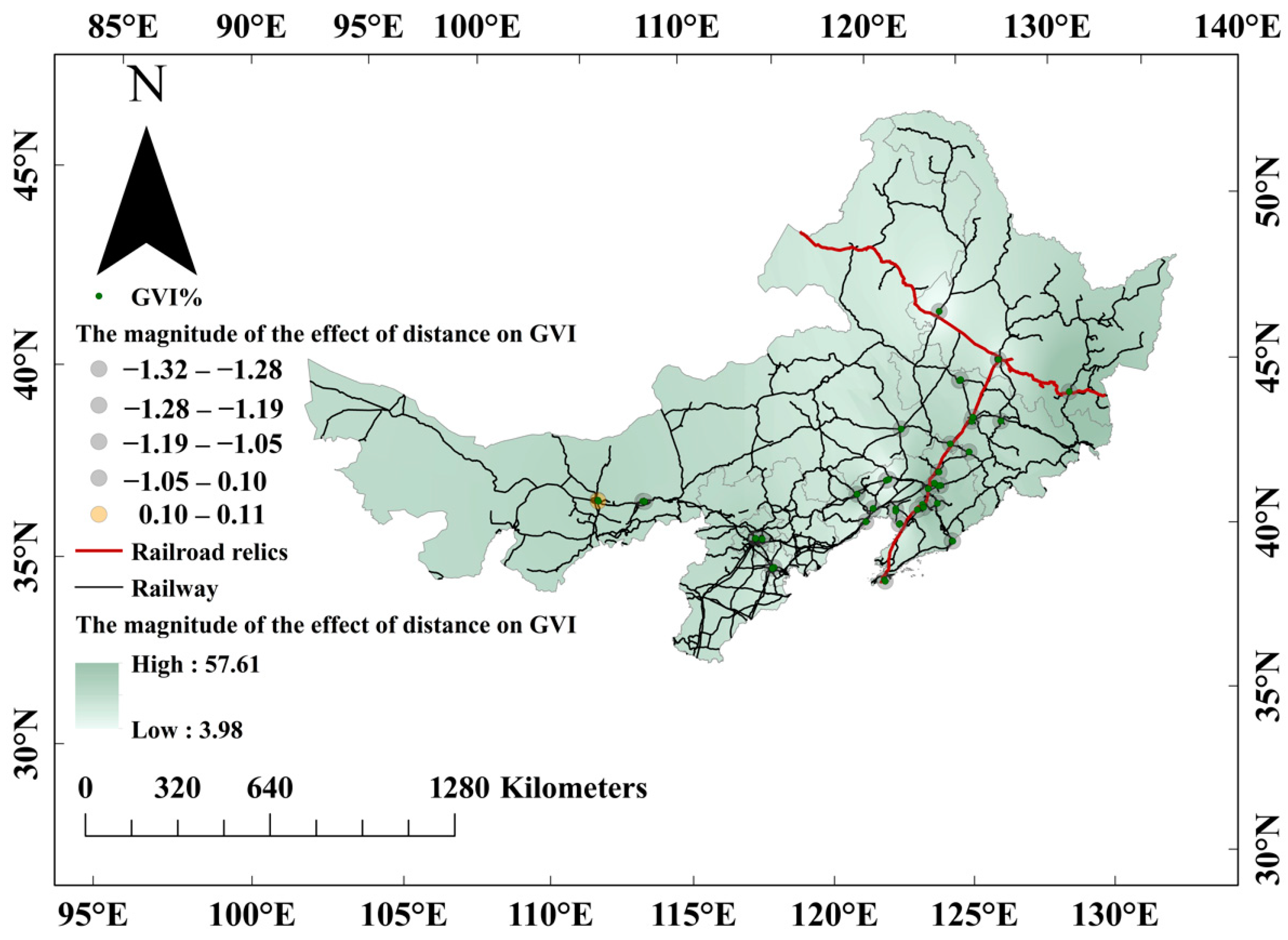Mapping Green View Index for Urban Parks with Varied Landscape Metrics and Distances toward the Chinese Eastern Railway Network
Abstract
:1. Introduction
2. Materials and Methods
2.1. Study Area and Plots
2.2. Data Collection
2.3. Statistical Analysis
3. Results
3.1. Spatial Distribution of GVI
3.2. Maximum Likelihood Analysis of Landscape and Distance Effects on GVI
3.3. Multivariate Linear Regression of GVI against Landscape Metrics
4. Discussion
4.1. Attributes of GVI in Urban Parks Distributed along CER Routes
4.2. Distance from CER Route Affects GVI in Nearby Parks
4.3. Landscape Metrics and GVI in Cities along CER Routes
5. Conclusions
Author Contributions
Funding
Institutional Review Board Statement
Informed Consent Statement
Data Availability Statement
Acknowledgments
Conflicts of Interest
References
- Vul, N. He, Who Has Sown the Wind: Karakhan, the Sino-Soviet conflict over the Chinese Eastern Railway, 1925–1926, and the failure of Soviet policy in northeast China. Mod. Asian Stud. 2014, 48, 1670–1694. [Google Scholar] [CrossRef]
- Zhao, Z.Q.; Wang, Q.L. Exploring the Protection Strategy of the Chinese Eastern Railway Culture Town under the Low-Carbon Background. In Proceedings of the 1st International Conference on Energy and Environmental Protection (ICEEP 2012), Hohhot, China, 23–24 June 2012; pp. 2799–2803. [Google Scholar]
- Li, Q.; Liu, D.P.; Song, J.S. The Chinese Eastern Railway: Geostrategic heritage from the turn of the twentieth century in Northeast China. J. Asian Archit. Build. Eng. 2023, 22, 2704–2723. [Google Scholar] [CrossRef]
- Zhao, Z.Q.; Wang, Q.L. Shaping the Vitality of the National List Historic Culture Town Based on the Theory of Urban Catalysts. In Proceedings of the 2nd International Conference on Structures and Building Materials (ICSBM), Hangzhou, China, 9–11 March 2012; pp. 1637–1641. [Google Scholar]
- Li, P.L.; Zhao, Z.Q.; Zhang, B.C.; Chen, Y.L.; Xie, J.Y. Understanding the Visual Relationship between Function and Facade in Historic Buildings Using Deep Learning-A Case Study of the Chinese Eastern Railway. Sustainability 2023, 15, 15857. [Google Scholar] [CrossRef]
- Zhao, Z.Q.; Li, S. The Design Framework of Spatial Nodes of Chinese Eastern Railway Culture Town—Case Study of National List Culture Town of Hengdaohezi Town. In Proceedings of the 2nd International Conference on Structures and Building Materials (ICSBM), Hangzhou, China, 9–11 March 2012; pp. 1395–1399. [Google Scholar]
- Dabezies, J.M. Heritagization of nature and its influence on local ecological knowledge in Uruguay. Int. J. Herit. Stud. 2018, 24, 828–842. [Google Scholar] [CrossRef]
- Kirshenblatt-gimblett, B. Intangible Heritage as Metacultural Production1. Mus. Int. 2004, 56, 52–65. [Google Scholar] [CrossRef]
- Hazen, H. Valuing natural heritage: Park visitors’ values related to World Heritage sites in the USA. Curr. Issues Tour. 2009, 12, 165–181. [Google Scholar] [CrossRef]
- Wang, S.J.; Duan, W.; Zheng, X.D. Post-Occupancy Evaluation of Brownfield Reuse Based on Sustainable Development: The Case of Beijing Shougang Park. Buildings 2023, 13, 2275. [Google Scholar] [CrossRef]
- Zhang, Q.; Lee, J.; Jiang, B.; Kim, G. Revitalization of the Waterfront Park Based on Industrial Heritage Using Post-Occupancy Evaluation-A Case Study of Shanghai (China). Int. J. Environ. Res. Public Health 2022, 19, 9107. [Google Scholar] [CrossRef]
- Zhu, A.L. Investigation on the Status Quo of Ecological Environment Construction in Northeast China from the Perspective of Dual Carbon Goals. J. Environ. Public Health 2022, 2022, 8360888. [Google Scholar] [CrossRef] [PubMed]
- Wang, X.P.; Meng, L.Q.; Liu, Y.F.; Wei, H.X. Facial Expressions of Urban Forest Visitors Jointly Exposed to Air Pollution and Regional Climate. Forests 2023, 14, 1571. [Google Scholar] [CrossRef]
- He, Q.; Wang, Y.; Qiu, Q.; Su, Y.; Wang, Y.; Wei, H.X.; Li, J.Y. Joint effects of air PM2.5 and socioeconomic dimensions on posted emotions of urban green space visitors in cities experiencing population urbanization: A pilot study on 50 cities of East China. Sci. Total Environ. 2023, 861, 160607. [Google Scholar] [CrossRef] [PubMed]
- He, Q.; Wang, Y.; Qiu, Q.; Su, Y.; Wei, H.X.; Li, J.Y. Posted Sentiments toward Experiences in Degraded Forests Are Shaped Jointly by Landscape Structure and Microclimate. Ecosyst. Health Sustain. 2023, 9, 0004. [Google Scholar] [CrossRef]
- Wei, H.X.; Hauer, R.J.; Sun, Y.X.; Meng, L.Q.; Guo, P. Emotional perceptions of people exposed to green and blue spaces in forest parks of cities at rapid urbanization regions of East China. Urban For. Urban Green. 2022, 78, 127772. [Google Scholar] [CrossRef]
- Hemeda, S. Geo-environmental monitoring and 3D finite elements stability analysis for site investigation of underground monuments. Horemheb tomb (KV57), Luxor, Egypt. Herit. Sci. 2021, 9, 17. [Google Scholar] [CrossRef]
- Anzani, A.; Invernizzi, F.C.; Maroldi, F.; Mura, R. Cultural potential of green spaces in urban areas. Setup o fknowledge tools. In Proceedings of the 10th International Technology, Education and Development Conference (INTED), Valencia, Spain, 7–9 March 2016; pp. 1135–1145. [Google Scholar]
- Pancewicz, A. Contemporary Parks in Post-Industrial Cities of Upper Silesian-Zaglebie Metropolis. In Proceedings of the 3rd World Multidisciplinary Civil Engineering, Architecture, Urban Planning Symposium (WMCAUS), Prague, Czech Republic, 18–22 June 2018. [Google Scholar]
- Dong, H.W.; Qin, B. Exploring the link between neighborhood environment and mental wellbeing: A case study in Beijing, China. Landsc. Urban Plan. 2017, 164, 71–80. [Google Scholar] [CrossRef]
- Huang, W.C.; Zhang, Y.; Shuai, B.; Xu, M.H.; Xiao, W.; Zhang, R.; Xu, Y.F. China railway industry reform evolution approach: Based on the Vertical Separation Model. Transp. Res. Part A-Policy Pract. 2019, 130, 546–556. [Google Scholar] [CrossRef]
- Mu, B.; Mayer, A.L.; He, R.Z.; Tian, G.H. Land use dynamics and policy implications in Central China: A case study of Zhengzhou. Cities 2016, 58, 39–49. [Google Scholar] [CrossRef]
- Fernandes-Ferreira, A.; Damaceno-Leite, A.; Chang, S.K.J. Accessible Tourism and the Role of Public Transport Provision: Comparing the Access to Attractions for Tourists with and without Disabilities in Bangkok. In Proceedings of the 13th Asia Pacific Transportation Development Conference—Resilience and Sustainable Transportation Systems, Shanghai Univ Engn Sci, Shanghai, China, 27–30 May 2020; pp. 19–27. [Google Scholar]
- Li, X.J. Examining the spatial distribution and temporal change of the green view index in New York City using Google Street View images and deep learning. Environ. Plan. B-Urban Anal. City Sci. 2021, 48, 2039–2054. [Google Scholar] [CrossRef]
- Yu, X.Y.; Qi, W. Measuring vegetation greenery in park using iPhone panoramic image and a new green vegetation extraction index. Urban For. Urban Green. 2021, 65, 127310. [Google Scholar] [CrossRef]
- Huang, S.Y.; Zhu, J.J.; Zhai, K.B.; Wang, Y.; Wei, H.X.; Xu, Z.H.; Gu, X.R. Do Emotional Perceptions of Visible Greeneries Rely on the Largeness of Green Space? A Verification in Nanchang, China. Forests 2022, 13, 1192. [Google Scholar] [CrossRef]
- Sun, Y.; Ma, X.T.; Liu, Y.F.; Meng, L.Q. Salary Satisfaction of Employees at Workplace on a Large Area of Planted Land. Land 2023, 12, 2075. [Google Scholar] [CrossRef]
- Luo, J.; Zhai, S.; Song, G.; He, X.; Song, H.; Chen, J.; Liu, H.; Feng, Y. Assessing Inequity in Green Space Exposure toward a “15-Minute City” in Zhengzhou, China: Using Deep Learning and Urban Big Data. Int. J. Environ. Res. Public Health 2022, 19, 5798. [Google Scholar] [CrossRef]
- Li, D.; Xu, H.Y.; Kang, Y.; Steemers, K. Systematic Review: Landscape Characteristics Correlated with Physical Activity of the Elderly People. Land 2023, 12, 605. [Google Scholar] [CrossRef]
- Gou, A.P.; Zhang, C.; Wang, J.B. Study on the identification and dynamics of green vision rate in Jing’an district, Shanghai based on deeplab V3+model. Earth Sci. Inform. 2022, 15, 163–181. [Google Scholar] [CrossRef]
- Xue, C.L.; Jin, C.; Zhou, L.C.; Li, G.N. Exploring the distribution of city street greenery from eye-level: An application of Baidu Map panoramic images data. Geogr. Tidsskr.-Dan. J. Geogr. 2022, 122, 73–86. [Google Scholar] [CrossRef]
- Zhu, J.; Qiu, L.; Su, Y.; Guo, Q.; Hu, T.; Bao, H.; Luo, J.; Wu, S.; Xu, Q.; Wang, Z.; et al. Disentangling the effects of the surrounding environment on street-side greenery: Evidence from Hangzhou. Ecol. Indic. 2022, 143, 109153. [Google Scholar] [CrossRef]
- Bilgili, B.C.; Satir, O.; Muftuoglu, V.; Ozyavuz, M. A simplified method for the determination of monitoring of green areas in urban parks using multispectral vegetation indices. J. Environ. Prot. Ecol. 2014, 15, 1059–1065. [Google Scholar]
- NASA Socioeconomic Data and Applications Center. Global Roads Open Access Data Set (gROADS), v1 (1980–2010). Available online: https://doi.org/10.7927/H4VD6WCT (accessed on 1 September 2023).
- Zhang, J.; Yang, Z.; Chen, Z.; Guo, M.Y.; Guo, P. Optimizing Urban Forest Landscape for Better Perceptions of Positive Emotions. Forests 2021, 12, 1691. [Google Scholar] [CrossRef]
- NASA Jet Propulsion Laboratory. ASTER Global Digital Elevation Map Announcement. Available online: https://asterweb.jpl.nasa.gov/gdem.asp (accessed on 1 September 2023).
- Li, H.Y.; Wang, X.G.; Wei, H.X.; Xia, T.T.; Liu, M.N.; Ai, S.S. Geographical Distribution and Driving Meteorological Forces of Facial Expressions of Visitors in Urban Wetland Parks in Eastern China. Front. Earth Sci. 2022, 10, 781204. [Google Scholar] [CrossRef]
- Duan, Y.; Guo, B.; Zhang, L.; Li, J.; Li, S.; Zhao, W.; Yang, G.; Zhou, S.; Zhou, C.; Song, P.; et al. Interactive climate-soil forces shape the spatial distribution of foliar N:P stoichiometry in Vaccinium uliginosum planted in agroforests of Northeast China. Front. Ecol. Evol. 2022, 10, 1065680. [Google Scholar] [CrossRef]
- Li, Y.J.; Sun, Y.X.; Zhao, Y.; Wang, Y.; Cheng, S.P. Mapping seasonal sentiments of people visiting blue spaces in urban wetlands: A pilot study on inland cities of China. Front. Ecol. Evol. 2022, 10, 969538. [Google Scholar] [CrossRef]
- Li, X.; Zhang, C.; Li, W.; Kuzovkina, Y.A.; Weiner, D. Who lives in greener neighborhoods? The distribution of street greenery and its association with residents’ socioeconomic conditions in Hartford, Connecticut, USA. Urban For. Urban Green. 2015, 14, 751–759. [Google Scholar] [CrossRef]
- Kumakoshi, Y.; Chan, S.Y.; Koizumi, H.; Li, X.; Yoshimura, Y. Standardized Green View Index and Quantification of Different Metrics of Urban Green Vegetation. Sustainability 2020, 12, 7434. [Google Scholar] [CrossRef]
- Wei, H.; Hauer, R.J.; Guo, S. Daytime dynamic of spontaneous expressions of pedestrians in an urban forest park. Urban For. Urban Green. 2021, 65, 127326. [Google Scholar] [CrossRef]
- Zhang, J.; Yang, Z.; Sun, Y.X.; Xu, Z.H.; Hui, T.F.; Guo, P. Experiencing urban forests for mitigation of negative emotions of people exposed to seasonal PM2.5 in Northeast China. J. For. Res. 2023, 34, 1245–1261. [Google Scholar] [CrossRef]
- Ulrich, R.S.; Simons, R.F.; Losito, B.D.; Fiorito, E.; Miles, M.A.; Zelson, M. Stress recovery during exposure to natural and urban environments. J. Environ. Psychol. 1991, 11, 201–230. [Google Scholar] [CrossRef]
- Kaplan, R.; Kaplan, S. The Experience of Nature: A Psychological Perspective; Cambridge University Press: New York, NY, USA, 1989. [Google Scholar]
- Wei, H.X.; Hauer, R.J.; Chen, X.; He, X.Y. Facial Expressions of Visitors in Forests along the Urbanization Gradient: What Can We Learn from Selfies on Social Networking Services? Forests 2019, 10, 1049. [Google Scholar] [CrossRef]
- Wei, H.; Ma, B.; Hauer, R.J.; Liu, C.; Chen, X.; He, X. Relationship between environmental factors and facial expressions of visitors during the urban forest experience. Urban For. Urban Green. 2020, 53, 126699. [Google Scholar] [CrossRef]
- Chia-pin, L. History of the Chinese Eastern Railway: A Chinese Version. Pac. Aff. 1930, 3, 188–211. [Google Scholar] [CrossRef]
- Norton, H.K. International Aspects of the Chinese Eastern Railway. Ann. Am. Acad. Political Soc. Sci. 1930, 152, 308–317. [Google Scholar] [CrossRef]
- Wang, J.B.; Liu, W.; Gou, A.P. Numerical characteristics and spatial distribution of panoramic Street Green View index based on SegNet semantic segmentation in Savannah. Urban For. Urban Green. 2022, 69, 127488. [Google Scholar] [CrossRef]
- Zheng, Y.; Zhu, J.L.; Wang, S.; Guo, P. Perceived Economic Values of Cultural Ecosystem Services in Green and Blue Spaces of 98 Urban Wetland Parks in Jiangxi, China. Forests 2023, 14, 273. [Google Scholar] [CrossRef]
- An, B.Y.; Wang, D.; Liu, X.J.; Guan, H.M.; Wei, H.X.; Ren, Z.B. The effect of environmental factors in urban forests on blood pressure and heart rate in university students. J. For. Res. 2019, 24, 27–34. [Google Scholar] [CrossRef]
- Guan, H.; Wei, H.; He, X.; Ren, Z.; An, B. The tree-species-specific effect of forest bathing on perceived anxiety alleviation of young-adults in urban forests. Ann. For. Res. 2017, 60, 327–341. [Google Scholar] [CrossRef]








| No. | Province | City | Park Name | Longitude | Latitude |
|---|---|---|---|---|---|
| 1 | Heilongjiang | Harbin | Clove Park | 126.561 | 45.742 |
| 2 | Heilongjiang | Mutankiang | North Hill Park | 129.588 | 44.605 |
| 3 | Heilongjiang | Tsitsihar | Crane City Park | 123.950 | 47.298 |
| 4 | Jilin | Jilin | Songhua River South Park | 126.552 | 43.826 |
| 5 | Jilin | Changchun | South Lake Park | 125.302 | 43.852 |
| 6 | Jilin | Changchun | North Lake Wetland Park | 125.358 | 43.974 |
| 7 | Jilin | Siping | Nanhu Park | 124.357 | 43.160 |
| 8 | Jilin | Liaoyuan | Dragon Mountain Park | 125.148 | 42.895 |
| 9 | Jilin | Songyuan | Mirror Lake Park | 124.804 | 45.128 |
| 10 | Jilin | Songyuan | Songhua River Forest Park | 124.859 | 45.156 |
| 11 | Liaoning | Benxi | Small Hua Mountain Park | 123.785 | 41.310 |
| 12 | Liaoning | Yingkou | Liao River Park | 122.239 | 40.679 |
| 13 | Liaoning | Yingkou | Jing Lake Park | 122.214 | 40.658 |
| 14 | Liaoning | Fuxin | People Park | 121.654 | 42.020 |
| 15 | Liaoning | Fuxin | Yulong Park | 121.748 | 42.050 |
| 16 | Liaoning | Liaoyang | White Tower Park | 123.170 | 41.277 |
| 17 | Liaoning | Liaoyang | Longding Mountain Park | 123.209 | 41.184 |
| 18 | Liaoning | Panjin | Zhongxing Park | 122.062 | 41.139 |
| 19 | Liaoning | Panjin | Xiushui Lake Park | 122.061 | 41.064 |
| 20 | Liaoning | Tieling | Culture Park | 123.835 | 42.291 |
| 21 | Liaoning | Tieling | Tieling Sport Park | 123.863 | 42.286 |
| 22 | Liaoning | Chaoyang | Chaoyang People Park | 120.447 | 41.569 |
| 23 | Liaoning | Huludao | Dragon Bay Park | 120.845 | 40.715 |
| 24 | Liaoning | Anshan | Yongle Park | 122.950 | 41.112 |
| 25 | Liaoning | Dalian | Labor Park | 121.641 | 38.917 |
| 26 | Liaoning | Dalian | Tiger Beach Ocean Park | 121.671 | 38.871 |
| 27 | Liaoning | Dandong | Jinjiang Mountain Park | 124.369 | 40.132 |
| 28 | Liaoning | Dandong | Yalu River Park | 124.392 | 40.122 |
| 29 | Liaoning | Fushun | Laodong Park | 123.919 | 41.865 |
| 30 | Liaoning | Fushun | Crescent Isle Park | 123.834 | 41.858 |
| 31 | Liaoning | Jinzhou | Beihu Park | 121.128 | 41.137 |
| 32 | Liaoning | Shenyang | Nan Lake Park | 123.407 | 41.768 |
| 33 | Liaoning | Shenyang | Qipanshan Beauty Spot | 123.665 | 41.938 |
| 34 | Inner Mongolia | Hohhot | Manduhai Park | 111.682 | 40.815 |
| 35 | Inner Mongolia | Hohhot | Chilechuan Park | 111.760 | 40.814 |
| 36 | Inner Mongolia | Baotou | Laodong Park | 109.869 | 40.657 |
| 37 | Inner Mongolia | Baotou | Saihantala Ecological Park | 109.897 | 40.627 |
| 38 | Inner Mongolia | Tongliao | Xilamulun Park | 122.255 | 43.630 |
| 39 | Beijing | Beijing | Olympic Forest Park | 116.387 | 40.026 |
| 40 | Beijing | Beijing | Dongjiao Wetalnd Park | 116.654 | 40.021 |
| 41 | Tianjin | Tianjin | Beining Park | 117.207 | 39.169 |
| 42 | Tianjin | Tianjin | Changhong Ecological Park | 117.146 | 39.133 |
| Variable | Parameter | Standard | Type II SS 1 | F Value | Pr > F |
|---|---|---|---|---|---|
| Estimate | Error | ||||
| Intercept | −28.57 | 49.69 | 38.71 | 0.33 | 0.5688 |
| Log(WA) 2 | 32.05 | 13.14 | 696.67 | 5.95 | 0.0197 |
| Longitude | 1.39 | 0.56 | 722.36 | 6.17 | 0.0177 |
| Latitude | −3.47 | 1.37 | 749.36 | 6.4 | 0.0158 |
| Log(DEM) 3 | 11.95 | 3.84 | 1135.50 | 9.69 | 0.0036 |
Disclaimer/Publisher’s Note: The statements, opinions and data contained in all publications are solely those of the individual author(s) and contributor(s) and not of MDPI and/or the editor(s). MDPI and/or the editor(s) disclaim responsibility for any injury to people or property resulting from any ideas, methods, instructions or products referred to in the content. |
© 2024 by the authors. Licensee MDPI, Basel, Switzerland. This article is an open access article distributed under the terms and conditions of the Creative Commons Attribution (CC BY) license (https://creativecommons.org/licenses/by/4.0/).
Share and Cite
Mo, W.; Sun, M.; Liu, T. Mapping Green View Index for Urban Parks with Varied Landscape Metrics and Distances toward the Chinese Eastern Railway Network. Sustainability 2024, 16, 1977. https://doi.org/10.3390/su16051977
Mo W, Sun M, Liu T. Mapping Green View Index for Urban Parks with Varied Landscape Metrics and Distances toward the Chinese Eastern Railway Network. Sustainability. 2024; 16(5):1977. https://doi.org/10.3390/su16051977
Chicago/Turabian StyleMo, Wei, Mingyang Sun, and Tong Liu. 2024. "Mapping Green View Index for Urban Parks with Varied Landscape Metrics and Distances toward the Chinese Eastern Railway Network" Sustainability 16, no. 5: 1977. https://doi.org/10.3390/su16051977





